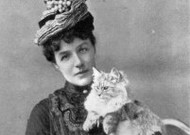History - Cat care in the 1900's
26th Jul 2023

According to Frances Simpson (1903): “One of the strangest and most profitable trades in London is the wholesale and retail business of horsemeat for cats. In barrows and carts the hawkers of this horse-flesh cry their wares throughout the city and suburbs, and find a ready sale for them. It is stated that 26,000 horses, maimed, or past work, are slaughtered and cut up each year to feed our household pets. Each horse means on an average 275 pounds of meat, and this is sold by pussy’s butcher in half pennyworths skewered on bits of wood. The magnitude of this trade can be estimated by the fact that it keeps constantly employed thirty wholesale salesmen. I may mention that a cats’-meat men’s supper was organised last year in London but the editor of Our Cats, assisted by Mr Louis Wain and others; and a most successful entertainment was given at the City of New York Restaurant. The applications for tickets were so numerous that 400 men had to be refused; and when the 250 guests were seated, it was clearly proved that every available inch of accommodation had been utilised. Having been present, I can testify to the excellent supper and entertainment provided for the cats’-meat men of London.”
Many of the horses would have been cab horses injured in road accidents or through overwork. It is ironic that in modern times, horsemeat may not be used in pet-food in the UK even though surplus ponies from Dartmoor and the New Forest are slaughtered (or shipped abroad for slaughter) annually. The only reason for this is a strange English taboo against eating horsemeat. The illustration is from 1883 “The Cat’s-Meat Man” and is a song celebrating this “Purveyor of Cat’s Meat to Her Majesty” (the legend on the basket and barrow in the bottom right corner). The song goes “He calls ‘Meat, Meat!’, All down the street; And dogs ‘bow-wow,’ And cats ‘mi-ow,’ While kittens sly Come purring by, As if to say – ‘Do serve us, pray, For we’re so small.’ The man throws bits Of meat to kits, And cats and dogs; Then on he jogs, And down the street Still cries ‘Meat, meat!'”
In her chapter on the “General Care and Management of Cats”, Simpson writes: “In the care, management, and feeding of cats no hard and fast rule can be laid down, for the dispositions and constitutions of these animals differ just as much as do those of human beings. Fanciers must therefore learn to treat their cats individually and not collectively; they must study their character and make allowances for the fads and fancies of the feline race. I am convinced that a varied diet is the best for cats, and fanciers should bear in mind the importance of regularity in the hours of feeding, whether two or three or four times a day. fresh water should always be supplied, and unfinished food should not be left standing about. For one or two pet cats the scraps from the kitchen table given with some judgment will probably suffice; but in the case of a large cattery with several inmates, some sort of system in feeding is necessary. I would suggest that the chief meal for two days a week should be fish, mixed perhaps with rice or Freeman’s Scientific Food, raw meat twice or three times a week cut up into fairly small pieces, horse-flesh (if obtained from a reliable source) twice a week. Lights, liver, or sardines may be given occasionally”.
“Spratt’s biscuits of various kinds, soaked and mixed with stock, are relished by some cats. Vegetables should be given frequently, and grass supplied, as green food purifies the blood and keeps the bowels in good condition. Persian cats require special attention as regards their coats, and should be combed and brushed regularly, and, if the fur becomes matted, the knots should be cut away. Avoid washing your cats; there are other means of cleansing their coats, particulars of which will be given in the chapter on exhibiting.”
